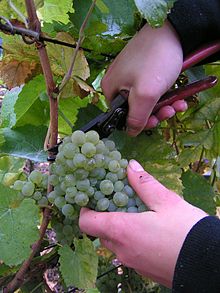Annual growth cycle of grapevines
The annual growth cycle of grapevines is the process that takes place in the vineyard each year, beginning with bud break in the spring and culminating in leaf fall in autumn followed by winter dormancy.From a winemaking perspective, each step in the process plays a vital role in the development of grapes with ideal characteristics for making wine.The amount of time spent at each stage of the growth cycle depends on a number of factors – most notably the type of climate (warm or cool) and the characteristics of the grape variety.During winter dormancy they turn brown until the spring when the vine begins the process of bud break and the first sign of green in the vineyard emerges in the form of tiny shoots.Eventually the shoots sprout tiny leaves that can begin the process of photosynthesis, producing the energy to accelerate growth.This is a potential viticultural hazard in places like the Margaret River region of Western Australia where warm currents from the Indian Ocean can coax Chardonnay vines to prematurely bud in the mid-winter month of July.Climate and the health of the vine play an important role with low humidity, high temperatures and water stress having the potential of severely reducing the percentage of flowers that get fertilized.Coulure occurs when there is an imbalance of carbohydrate levels in the vine tissues and some berries fail to set or simply fall off the bunch.On one cluster there may be berries of various sizes which can create problems during winemaking due to the varying "skin to pulp" ratio among the grapes.This is because the vine is biologically programmed to channel all its energies and resources into the berries, which houses its seedling offspring, to provide them a better chance of survival.[8] In the vineyard, the antepenultimate event is the harvest in which the grapes are removed from the vine and transported to the winery to begin the wine making process.





dormancywinemakinggrapesViticulturalistsvine diseasevine'sfloweringveraisonharvestingcanopy managementirrigationvine trainingagrochemicalsgrape varietyRegentpetioleSouthern Hemisphereprunedosmoticorganic acidshormonesmineralsroot systemshootscarbohydratephotosynthesistemperate climatesChardonnayMargaret RiverpollinationfertilizationpollenanthersstigmaVitis viniferahermaphroditicstamensovariesself-pollinatecalyptracross-pollinationCabernet SauvignonCabernet FrancSauvignon blancPetite SirahPeloursinhumidityCoulureGrenacheMalbecMillerandagefanleafGewürztraminerclonesRipeness in viticultureripeningchlorophyllanthocyaninscarotenoidsengustmentsugarsglucosefructosecanopywater stressHarvest (wine)harvestripenessmalic acidTanninsphenolicsgrey rotBBCH-scale (grape)Wayback MachineViticultureAmpelographyGrape varietiesHybrid grapeInternational Grape Genome ProgramRootstockVineyardClimate categoriesDiurnal temperature variationDrainageMicroclimateRegional climate levelsSoil typesTerroirTopographyaspectelevationGrapevine plantingPropagationRow orientationTrellis designErosion controlFertilizerFrost damage preventionIntegrated pest managementKlopotecPruningWeed controlFestivalsNoble rotVintageWeatherdiseasesBlack rotBotrytis bunch rotBot cankerDead armDowny mildewGrapevine yellowsGreat French Wine BlightNematodesPhylloxeraPierce's diseasePowdery mildewUncinula necatorRed spider miteVine mothAdaptive managementBiodynamic wineEffects of climate change on wine productionEnvironmental stewardshipOrganic farming
